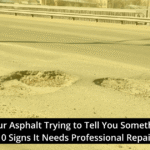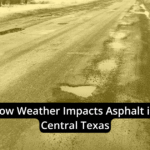When you’re managing a pavement project in Austin, TX, one critical factor often overlooked is drainage. Think of proper drainage as the foundation beneath the surface; it quietly determines whether your asphalt lasts decades or fails in just a few years. At Contractors Asphalt, we understand how surface slope, base stability, and water management come together to make a pavement perform. From 1.5 % to 2 % cross-slope design to positive outlets and base layer checks, these details matter more than you might think. Let’s dig into why drainage matters, common failures we see, and how investing a little up front pays big dividends in longevity, maintenance, and cost.
Why Drainage Matters for Asphalt Longevity
Asphalt pavement isn’t simply laid on top of soil and left to idle; it lives and functions by shedding water, resisting oxidation, and staying structurally stable under load. When drainage is neglected, you get faster oxidation of the binder, increased raveling, moisture-induced cracking, and alligator cracking. At Contractors Asphalt, we emphasise: our job isn’t just paving the surface, it’s engineering for durability in Austin’s climate. That means designing slopes, verifying outlets, and ensuring the base isn’t saturated. A pavement with proper slope and drainage avoids trapped water, retains its modulus and support, and avoids costly repairs or early replacement.
Common Water-Related Failures in Pavement
When water penetrates beneath the asphalt surface or remains in the subbase, we observe predictable failure modes:
- Stripping and raveling: Asphalt binder gets broken down, and aggregate comes loose.
- Potholes and cracking: Moisture weakens the base, and under traffi,c the surface fails.
- Edge failures: Without proper edge drains or curbing, water can undermine the pavement edge, causing crumbling.
- Base softening/pumping: In areas where water flows laterally or saturates the base, you get pumping of fines and base loss.
- At Contractors Asphalt, we check for these conditions before we pave or repair, and we integrate drainage or structural fixes as needed to prevent repeat problems.
Grading and Slope Requirements for Runoff
Proper grading remains the first line of defence. In Austin, we typically aim for finished asphalt grades that reliably shed water: a cross-slope of 1.5 % – 2.0 % is a common target for drive aisles or parking lots, while longitudinal slope should generally exceed 1.0% to avoid ponding. If the grade doesn’t naturally allow slope, we recommend re-grading or installing inlets/back-channels. At Contractors Asphalt, we review your site, ensure positive drainage paths, and avoid reverse crowns or sag areas that trap water.
| Requirement | Typical Target / Note |
| Cross-slope | ~2.0% ±0.5% |
| Longitudinal slope | ??1.0% for run?off |
| ADA pedestrian routes | ??2.0% cross?slope |
| Inlet spacing | Designed to avoid ponding |
Subbase Preparation and Soil Considerations
Good surface slope matters, but what happens underneath matters more in the long run. We start with a site assessment: what’s the soil classification (clay, sand, etc.)? What’s the groundwater behavior? At Contractors Asphalt, we ensure that after grading, the subbase and fill materials are compacted to specification and free?draining where required. Moisture?sensitive soils (like expansive clays in Central Texas) require careful conditioning. Our crews apply proven methods: proof?roll lifts, ensure 95%+ relative compaction, use subbase materials if needed, and verify drainage continuity before asphalt placement.
Choosing the Right Drainage Structures
Slope alone won’t solve all issues. Where natural grades or watersheds create flow paths, we incorporate inlets, drains, and hydraulic conveyance designed for the project’s needs. On commercial lots, we design curb inlets or area drains; on rural or industrial drives, we may add under?drains. At Contractors Asphalt, we select materials and layouts that suit Austin’s traffic loads, rainfall intensities, and lot configurations. Proper installation and maintenance of those structures help preserve the pavement and avoid costly deterioration.
Managing Water at Driveway and Parking Lot Edges
Slope alone won’t solve all issues. Where natural grades or watersheds create flow paths, we incorporate inlets, drains, and hydraulic conveyance designed for the project’s needs. On commercial lots, we design curb inlets or area drains; on rural or industrial drives, we may add under?drains. At Contractors Asphalt, we select materials and layouts that suit Austin’s traffic loads, rainfall intensities, and lot configurations. Proper installation and maintenance of those structures help preserve the pavement and avoid costly deterioration.
Preventing Ponding and Heat-Related Issues
Austin sees intense storms and high sun exposure, so ponding water on a flat surface invites damage, whether through heat-induced softening, oxidation, or simply accelerated breakdown. We ensure asphalt surfaces are uniformly crowned, avoid low spots, and use proper inlet spacing and design to handle runoff quickly. Maintenance standards such as cleaning drains, verifying slopes, and vacuuming debris are part of our process.
Maintenance Practices to Keep Drains Functional
Installation is only half the job; keeping drainage functioning is the rest. At Contractors Asphalt, we recommend routine inspections and drain maintenance: clearing inlets, checking sumps, verifying cross slopes, and removing sediment. When drains clog or shut off, the pavement becomes vulnerable again. By maintaining the drainage system, we help the asphalt surface continue to perform well and last longer.
Drainage Planning for Austin and Central Texas Conditions
In Austin, drainage design must reflect the local climate: Texas storms, variable soils, and urban development. At Contractors Asphalt, we design using site?specific rainfall data, soil assessments, and drainage pathways that reflect the region’s conditions. We integrate surface and subsurface drainage solutions and ensure our work accounts for both residential and commercial projects across Central Texas.
Cost and ROI Benefits of Proper Drainage Design
Investing in proper drainage design upfront often lowers total ownership cost dramatically. A pavement with well?designed slope, outlets, grading, and base prep can last 30?50% longer, experience fewer repairs and avoid early overlays or reconstruction. At Contractors Asphal,t we factor these benefits into our proposals for clients in Austin, helping you see the value of doing it right the first time.
Conclusion
In summary: manage water thoughtfully, design proper slopes, make sure the base and edge details work, and keep drainage maintained. That’s how you get pavement that performs. For your next asphalt or repair project in Austin, TX, trust Contractors Asphalt to handle not only the visible surface but the critical drainage infrastructure underneath. Contact us today to schedule a drainage assessment and project consultation in the Austin area.









